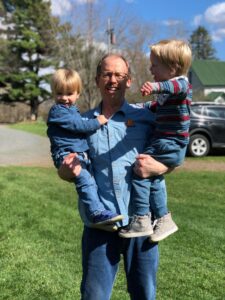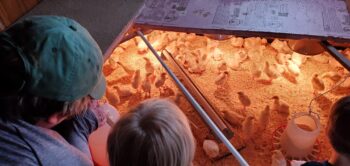 By Pastor John Hulden
By Pastor John Hulden
One million dead from COVID in the U.S. I know, that’s not a great way to start a blog. But, it is really big news that, well, is not really new; it’s a tragedy. That’s 1,000,000 people – an ever-growing number that is an unfathomable catastrophe. Now, let’s talk birds.
This pandemic is for bird watching
Perhaps you have heard that bird watching is way, way, up during the last two years. Isolating at home, working from home, only able to meet outside — whether you look out your windows or step outside, there are birds. Many folks took up the official hobby of “birding.” Using apps like eBird and Merlin, the enthusiasm of these “birders” has led to a surge of bird data these past two years; more birds are being watched and tallied.

From the porch of the farmhouse
“Just like it was for our kids when they were little, the farm is a pretty cool place for our two young Minneapolis-living grandsons to visit.”
I am not a “birder.” Brenda and Nick are the resident “birders” on your synod staff. But I live on my wife’s childhood farm with her parents (my favorite parents-in-law). Just like it was for our kids when they were little, the farm is a pretty cool place for our two young Minneapolis-living grandsons to visit.

Our two young Minneapolis-living grandsons
Now that we got past April (that felt like November), I can sit on the front porch with a lovely view when I work from home. While plowing through my emails, I can hear birds. I can see birds. There are so many birds. I don’t need to be “birder” to recognize the many different birds on our 47-acre farm: songbirds of every color, sandhill cranes, bald eagles, vultures, turkeys, Canadian geese, barn swallows, hummingbirds, woodpeckers, various kinds of ducks on our two ponds.
One day there was a racket coming from a stand of trees. I caught on video a green heron taking down a chipmunk from the top limb of 75-foot tree. It didn’t go well for the chipmunk.
Living on a farm we see firsthand the cycle of life. Which leads me to …
There is a pandemic for birds, too
My wife is the farmer. She cares for five dozen laying hens and almost 100 baby chicks that are “meat birds.” She had arranged with our neighbors to butcher those fast-growing chicks in early June.
First one laying hen, and then a few more of our laying hens, died. After calling the Minnesota Avian Flu hotline, scientists came out to the farm to test the birds. We soon found out we are the 77th Minnesota farm to get hit with the Avian Flu. Soon after that, USDA hazmat-fitted workers from Willmar came to our farm and killed all 165 chickens and we buried them out in the field — along with the eggs we were getting ready to sell.
It was a very sad day. Now our farm needs to stay poultry free for 150 days.

Chicks that would have become chickens
“After calling the Minnesota Avian Flu hotline, scientists came out to the farm to test the birds.”
How did this happen? I guess all it takes is infected droppings from a migratory bird landing in our chicken yard. Boom. Infected farm #77. As if one pandemic wasn’t enough.
We’ll be alright. Now there will be more time for work in the vegetable and flower gardens.
Any day is a good day to make a “grateful-for” list. Ours is long: care and concern from neighbors and friends, good science and scientists, government help from the USDA, Easter Season worship services and sermons, even deeper appreciation of creation, and the creation chapters in Job (39:26-30), and the Psalms (50:7-12), and, well, Jesus:
“Therefore, I tell you, do not worry about your life, what you will eat or what you will drink, or about your body, what you will wear. Is not life more than food, and the body more than clothing? Look at the birds of the air; they neither sow nor reap nor gather into barns, and yet your heavenly Parent feeds them. Are you not of more value than they? And can any of you by worrying add a single hour to your span of life?” Matthew 6:25-27
